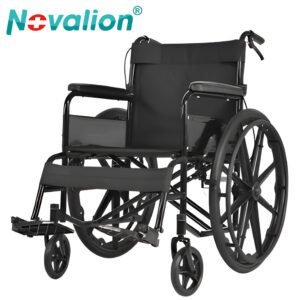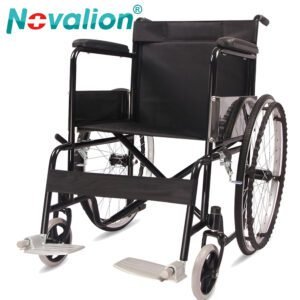Custom Wheelchair: 5 Key Questions Answered—From Design Process to Costs & User Benefits
For many wheelchair users, standard models fall short: a seat that’s too narrow, backrests that don’t support curvature, or wheels that don’t match their strength. A custom wheelchair solves this by being built for you—not a generic “average user.” But what exactly makes a wheelchair “custom,” who needs one, and how does the process work? Here are 5 critical questions answered to demystify this personalized mobility solution.
1. What Defines a Custom Wheelchair?
A custom wheelchair is a one-of-a-kind mobility device engineered to match an individual’s unique body, medical needs, and lifestyle. Unlike standard or pre-made wheelchairs (mass-produced with fixed dimensions), it’s designed from the ground up with these traits:
- Tailored Dimensions: Every measurement—seat width/depth, backrest height, footrest angle—is based on the user’s body (e.g., a 17-inch seat for narrow hips vs. a 22-inch seat with lateral supports for scoliosis).
- Medical Alignment: Built to address specific conditions, such as tilting the seat to reduce spinal pressure (for spinal cord injuries) or adding headrests to stabilize neck weakness (for cerebral palsy).
- Functional Flexibility: Adjusted to the user’s strength (e.g., larger hand rims for those with limited grip) or activity level (e.g., reinforced frames for athletes).
2. What Is the Custom Design Process?
Creating a custom wheelchair is a collaborative journey, typically spanning 4–8 weeks:
- Clinical Assessment: An occupational therapist (OT) or physical therapist (PT) measures the user’s body (hip width, leg length, spinal curvature) and assesses mobility goals (e.g., “needs to navigate stairs” or “requires pressure relief for 8-hour sits”).
- Design Planning: Engineers or wheelchair specialists use 3D modeling to draft a frame that integrates the therapist’s recommendations—for example, adding lumbar support for a user with lower back pain.
- Prototype & Testing: A mockup or adjustable prototype is built for the user to trial. Feedback (e.g., “footrests are too high”) leads to revisions.
- Fabrication: The final wheelchair is built with custom components—e.g., a contoured foam seat molded to the user’s body, or a lightweight carbon fiber frame for easy self-propulsion.
- Delivery & Fine-Tuning: After delivery, therapists make minor adjustments (e.g., tightening armrests) to ensure perfect fit.
3. Who Benefits Most from a Custom Wheelchair?
It’s life-changing for users whose needs can’t be met by standard models:
- Users with Unique Body Shapes: Those with scoliosis, amputations, or disproportionate limbs (e.g., long legs, short torso) need custom dimensions to avoid pain.
- Complex Medical Conditions: Spinal cord injuries, cerebral palsy, or spina bifida often require specialized support (e.g., tilt-in-space seats to prevent pressure sores).
- Long-Term Users: People relying on wheelchairs 8+ hours daily benefit from tailored comfort, reducing fatigue and complications.
- Athletes & Active Users: Sports enthusiasts may need custom frames for wheelchair basketball (low-profile, lightweight) or off-road adventures (reinforced wheels).
4. What Features Can Be Customized?
Nearly every component is adjustable to fit the user:
Frame & Structure:
- Material: Carbon fiber (lightest, $$$), aluminum (balanced, $), or steel (durability, $).
- Dimensions: Seat width (14–30+ inches), backrest height (12–24 inches), and wheelbase (stability vs. maneuverability).
Support Systems:
- Seats: Contoured foam, gel cushions, or air-filled pads (custom-molded to the user’s pressure points).
- Head/Neck Support: Adjustable headrests, lateral (side) supports, or harnesses for users with weak muscles.
Functionality:
- Movement: Recline, tilt, or standing functions (for users needing to shift positions).
- Propulsion: Hand rim size/shape (ergonomic for grip strength) or powered options (joysticks, sip-and-puff controls).
Aesthetics: Upholstery color, custom logos, or accessory mounts (for phones, oxygen tanks).
5. What Influences the Cost, and How to Manage It?
Custom wheelchairs range from $2,000 to $15,000+—here’s why, and how to offset costs:
Cost Drivers:
- Materials: Carbon fiber adds $1,000–$3,000 vs. aluminum.
- Complexity: Powered functions (e.g., standing) or 3D-molded seats increase costs.
- Clinical Fees: Assessments and therapist consultations add $500–$1,500.
Managing Expenses:
- Insurance: Many plans cover custom wheelchairs if deemed “medically necessary” (requires therapist/doctor documentation).
- Grants/Nonprofits: Organizations like the Christopher & Dana Reeve Foundation offer financial aid.
- Phased Customization: Start with essential features (e.g., a custom seat) and add others later.
Conclusion
A custom wheelchair isn’t just a mobility aid—it’s a reflection of the user’s unique needs and lifestyle. By prioritizing personalization, it transforms “getting by” into thriving, whether through pain-free daily use, enhanced independence, or the ability to pursue hobbies. For those who need it, customization isn’t a luxury—it’s a lifeline.
Thank you for reading this, dear, if you have any suggestions about our website or want to know about wheelchair, please contact us. We will respond quickly.



